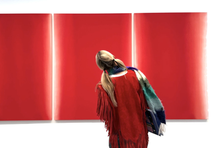Sustainability on the Runway: Men's London Fashion Week
- The Courtauldian
- Jan 27, 2020
- 3 min read
Just a week into the new year and the tone had already been set; the calls for a more sustainable way of living were being heralded loud and clear. These were demands that did not go unanswered as designers gathered in the East End of the nation’s capital to showcase their vision of an eco-conscious wardrobe in what was to be the fashion week to open the decade (January 4, 2020 - January 6, 2020).
The first day of the event commenced with an apocalypse-ready collection from Paria Farzaneh. As the designer herself stated, the changing climate has resulted in the necessity for ‘windproof, waterproof, heat-sensitive, [and] environmentally sensitive’ clothing. With an army of earthy-toned anoraks made from weather-resistant Gore-Tex fabric, wearers of her garments were sure to be protected from the extreme British elements. The use of insulation and nylon created from recycled bottles and fishing nets further added to the brand’s credentials as an ecological business. Visually, the recurring theme of Farzaneh’s designs was a paisley pattern, which was woodblock printed in Iran using saffron and turmeric. This motif, placed on everything from trousers to pocket-linings, beautifully contrasted with the more technologically advanced materials seen throughout the collection.

Illustration by Vitoria Mendes
Farzaneh’s show was immediately followed by that of Bethany Williams, a designer not unused to limelight. Having won a plethora of accolades including the Queen Elizabeth II Award for design and an award for British Emerging Menswear Talent, the show was an inevitable success that also drew focus on the wider impact of clothing. The collection comprised of a vibrant rainbow of patchwork coats and streetwear made out of either organic or recycled materials including an old bell tent. Its brightness was enough to lift the spirits of anyone in the audience suffering from the January blues. What also lifted the audience’s spirits was the knowledge that it was made in collaboration with the Magpie Project, a charity who works to support mothers and young children living in temporary accommodation. Therefore, when a man ‘supports or buys the collection in store, he’s helping to fund all these projects [that aid] women’. It was clearly fashion with a cause.
As Fashion Week tippled through to Sunday, a more controversial idea of sustainability was offered by the Copenhagen-based designer Astrid Anderson. Her floor-length coats caused quite a stir amongst the audience due to their use of real animal fur. This material is now largely shunned by fashion houses based on ethical and environmental grounds. Anderson, however, advocates that the real thing is more sustainable than its polyester faux alternative. Regardless of whether they were genuine or not, the pieces perfectly complemented her psychedelic styling that paired both camouflage and ponchos with her characteristic streetwear aesthetic. It appeared to be the ultimate battle between garments once clad by the peace-loving hippies of the seventies with fabrics drawn from military attire. It was a tantalising juxtaposition that looked as if it belonged to a post-apocalyptic society of the future, just hopefully not our future.
With environmental issues at the forefront of people’s minds, it was unsurprising to see such a large focus on sustainability at Men’s London Fashion Week this January. Whether the emphasis on such an important cause will be translated into action in the years to come, however, is conjecture.












Comments